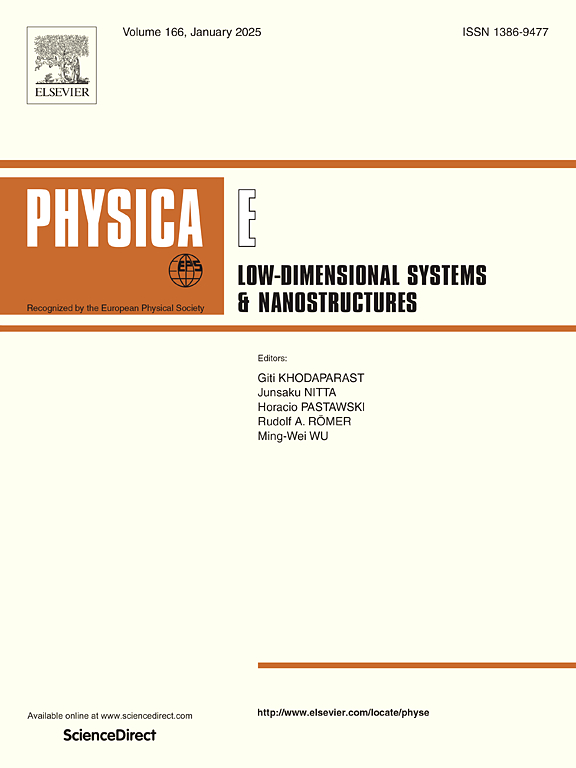Three-frequency optical switch with dynamically tunable and polarimetric insensitive multifunctional device
IF 2.9
3区 物理与天体物理
Q3 NANOSCIENCE & NANOTECHNOLOGY
Physica E-low-dimensional Systems & Nanostructures
Pub Date : 2025-05-28
DOI:10.1016/j.physe.2025.116297
引用次数: 0
Abstract
Plasmon-Induced Transparency (PIT) has garnered considerable research attention across diverse photonic architectures, spanning photonic crystal resonators, metal-insulator-metal (MIM) waveguides, plasmonic grating arrays, and micro-electro-mechanical systems (MEMS). This study presents a dynamic tunable multifunctional photonic device based on a graphene-VO2 composite structure. By designing a metasurface, a polarization-independent plasmon-induced transparency (PIT) effect is achieved, showcasing a novel approach to integrating the tunability of graphene and VO2. The device enables dual-mode dynamic control, with optical switching performance including a 98 % modulation depth, 1.28 dB insertion loss, and 16.78 dB extinction ratio. Additionally, it exhibits significant slow-light effects, with a maximum group index of 633. This design combines dual-mode dynamic adjustability, polarization insensitivity, and the functionality of optical switches, providing a new development direction for integrated photonic devices and having potential application prospects in the fields of optical communication and sensing.
三频光开关,动态可调,偏振不敏感多功能装置
等离子体诱导透明(PIT)在不同的光子结构中获得了相当大的研究关注,包括光子晶体谐振器、金属-绝缘体-金属(MIM)波导、等离子体光栅阵列和微机电系统(MEMS)。本研究提出了一种基于石墨烯- vo2复合结构的动态可调谐多功能光子器件。通过设计一个超表面,实现了极化无关的等离子体诱导透明(PIT)效应,展示了一种集成石墨烯和VO2可调性的新方法。该器件支持双模动态控制,光开关性能包括98%的调制深度,1.28 dB插入损耗和16.78 dB消光比。此外,它还表现出明显的慢光效应,最大群指数为633。本设计结合了光开关的双模动态可调性、偏振不灵敏度和光开关的功能性,为集成光子器件提供了新的发展方向,在光通信和传感领域具有潜在的应用前景。
本文章由计算机程序翻译,如有差异,请以英文原文为准。
求助全文
约1分钟内获得全文
求助全文
来源期刊
CiteScore
7.30
自引率
6.10%
发文量
356
审稿时长
65 days
期刊介绍:
Physica E: Low-dimensional systems and nanostructures contains papers and invited review articles on the fundamental and applied aspects of physics in low-dimensional electron systems, in semiconductor heterostructures, oxide interfaces, quantum wells and superlattices, quantum wires and dots, novel quantum states of matter such as topological insulators, and Weyl semimetals.
Both theoretical and experimental contributions are invited. Topics suitable for publication in this journal include spin related phenomena, optical and transport properties, many-body effects, integer and fractional quantum Hall effects, quantum spin Hall effect, single electron effects and devices, Majorana fermions, and other novel phenomena.
Keywords:
• topological insulators/superconductors, majorana fermions, Wyel semimetals;
• quantum and neuromorphic computing/quantum information physics and devices based on low dimensional systems;
• layered superconductivity, low dimensional systems with superconducting proximity effect;
• 2D materials such as transition metal dichalcogenides;
• oxide heterostructures including ZnO, SrTiO3 etc;
• carbon nanostructures (graphene, carbon nanotubes, diamond NV center, etc.)
• quantum wells and superlattices;
• quantum Hall effect, quantum spin Hall effect, quantum anomalous Hall effect;
• optical- and phonons-related phenomena;
• magnetic-semiconductor structures;
• charge/spin-, magnon-, skyrmion-, Cooper pair- and majorana fermion- transport and tunneling;
• ultra-fast nonlinear optical phenomena;
• novel devices and applications (such as high performance sensor, solar cell, etc);
• novel growth and fabrication techniques for nanostructures

 求助内容:
求助内容: 应助结果提醒方式:
应助结果提醒方式:


